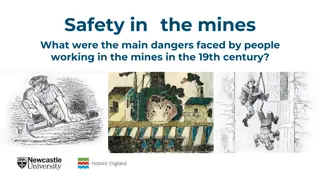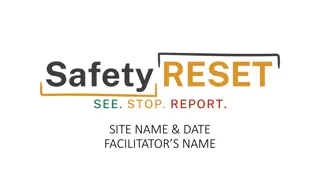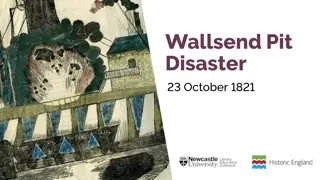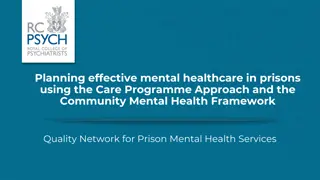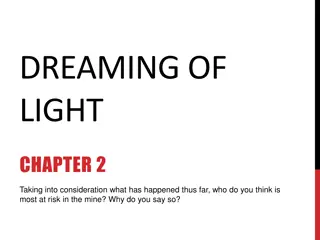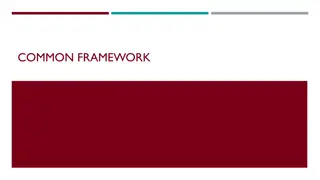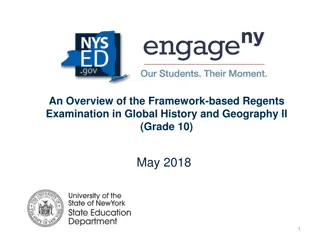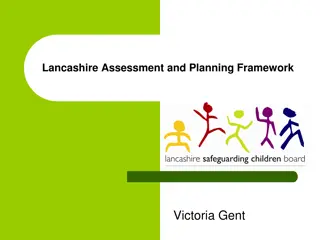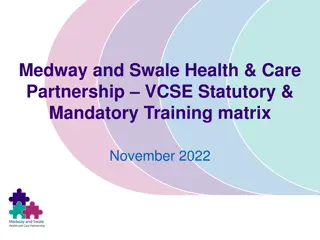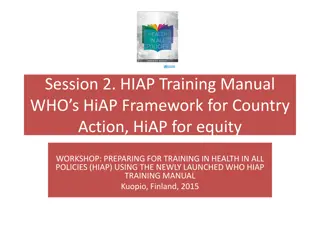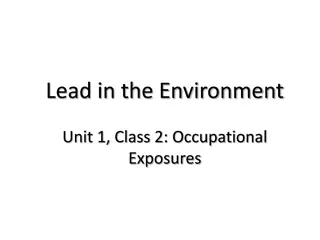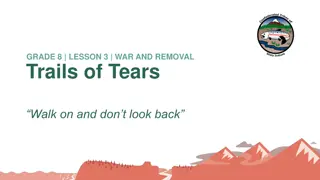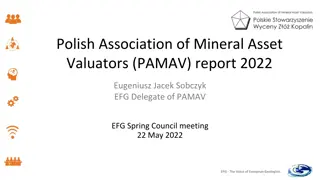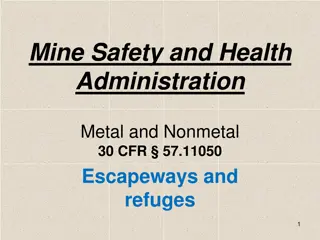Improving Miners' Health through New Framework
A new framework is introduced to enhance miners' health by addressing various stressors, hazards, and knowledge gaps in the mining industry. The project involves collaboration with NIOSH and emphasizes data exploration and systematic health data reviews to improve outcomes for miners.
Download Presentation

Please find below an Image/Link to download the presentation.
The content on the website is provided AS IS for your information and personal use only. It may not be sold, licensed, or shared on other websites without obtaining consent from the author.If you encounter any issues during the download, it is possible that the publisher has removed the file from their server.
You are allowed to download the files provided on this website for personal or commercial use, subject to the condition that they are used lawfully. All files are the property of their respective owners.
The content on the website is provided AS IS for your information and personal use only. It may not be sold, licensed, or shared on other websites without obtaining consent from the author.
E N D
Presentation Transcript
A New Framework for Improving Miners Health: Update WestON, SEPT 15-16 DENVER CO| Aaron Sussell, PhD, MPH, CIH The findings and conclusions in this report are those of the authors and do not necessarily represent the official positions of the National Institute for Occupational Safety and Health or the Centers for Disease Control and Prevention. NIOSH Mining Program 1
A New Framework for Improving Miners Health: Update WestON, SEPT 15-16 DENVER CO| Aaron Sussell, PhD, MPH, CIH NIOSH Collaborators NIOSH Collaborators SMRD SMRD Kristin Yeoman Tashina Robinson Shilpi Misra Carol Nixon Jerry Poplin Samantha Wilson Danielle Mancillas Yongli Zhao Alex Johnson WSD WSD Ryan Hill Kyla Hagen-Haynes (Retzer) Kenneth Scott The findings and conclusions in this report are those of the authors and do not necessarily represent the official positions of the National Institute for Occupational Safety and Health or the Centers for Disease Control and Prevention. NIOSH Mining Program 2
Mining: a variety of stressors that affect workers health Work Organization Work Organization Shift work Isolation Difficult entry & egress Long commutes Health hazards Health hazards --Noise/radiation --hot/cold environment --Dust/fumes/exhaust --Repetitive motion/lifting --Vibration Safety hazards Safety hazards Vehicles /heavy machinery Catastrophic events 3 3
Mining is in all states, and most counties *Mining, except oil and gas extraction. Data source: MSHA, 2020 4
This project is addressing knowledge gaps for miners health Data Data Good Good Insufficient Insufficient Injuries Injuries Health Health outcomes outcomes Health Health- - exposures exposures 5
We explore and mine existing data macro level Systematic review of health data sources Systematic review of health data sources Evaluated: 20 Currently in use: 5 Used prior to this project: 1 6
Demographics in mining differ from all other industries College or Technical School-Attended or Graduated College or Technical School-Attended or Graduated Other - non Hispanic Other - non Hispanic Hispanic Hispanic Black - non Hispanic Black - non Hispanic White - non Hispanic White - non Hispanic Age >= 55 years Age >= 55 years BRFSS 2014-2018 38 states Sex - Male Sex - Male 0 20 40 60 80 100 All other industries OGE Mining, except OGE 7
Mining industry and Construction & extraction occupations: highest suicide rates Industry Sector Industry Sector 0 10 20 30 40 50 60 27 27 ALLCURRENTWORKERS, 2016, 32 STATES 7.7 7.7 54 54 MININGAND OILAND GAS EXTRACT 45 45 CONSTRUCTION 39 39 OTHER SERVICES 8.8 8.8 30 30 TRANSPORTATIONAND WAREHOUSING 10 10 26 26 ADMINISTRATIVEAND SUPPORTAND WASTE MGMT SERVICES 5.2 5.2 19 19 HEALTH CAREAND SOCIAL ASSISTANCE Male Male 7.5 7.5 15 15 FINANCEAND INSURANCE 6 6 Female Female 9.3 9.3 EDUCATIONAL SERVICES 3.9 3.9 National Violent Death Reporting System, 32 States, 2016 Rates per 100,000 workers 8
Industry Sector Industry Sector Mining industry and Construction & extraction occupations: highest suicide rates 0 10 20 30 40 50 60 27 27 ALLCURRENTWORKERS, 2016, 32 STATES 7.7 7.7 54 54 MININGAND OILAND GAS EXTRACT 45 45 CONSTRUCTION 39 39 OTHER SERVICES 8.8 8.8 30 30 TRANSPORTATIONAND WAREHOUSING 10 10 26 26 ADMINISTRATIVEAND SUPPORTAND WASTE MGMT SERVICES 5.2 5.2 19 19 HEALTH CAREAND SOCIAL ASSISTANCE Male Male 7.5 7.5 15 15 FINANCEAND INSURANCE 6 6 Female Female 9.3 9.3 EDUCATIONAL SERVICES 3.9 3.9 Occupation Group 0 10 20 30 40 50 60 National Violent Death Reporting System, 32 States, 2016 Rates per 100,000 workers 27 ALLCURRENTWORKERS, 2016, 32 STATES 7.7 49 CONSTRUCTIONAND EXTRACTION 26 37 INSTALLATION, MAINTENANCE, AND REPAIR 31 FARMING, FISHING, AND FORESTRY 30 TRANSPORTATIONAND MATERIAL MOVING 12.5 15 COMMUNITYAND SOCIAL SERVICE 6.2 Male 14 OFFICEAND ADMINISTRATIVE SUPPORT 5.4 12 BUSINESSAND FINANCIAL OPERATIONS Female 4.7 10 EDUCATION, TRAININGAND LIBRARY 3.9 9
Miners have higher prevalence of some risk behaviors BRFSS Industry and Occupation Module, 2013-2017 Miners and oil and gas workers combined have higher prevalence 32 Participating states: 32 Participating states: AK, CA, CO, CT, FL, GA, HI, ID, IL, IA, LA, MD, MA, MI, MN, MS, MT, NE, NH, NJ, NM, NY, NC, ND, OR, TN, UT, VT, WA WV, WI, WY estimates of smokeless tobacco use, not always wearing seat belts, inadequate sleep, and obesity Yeoman, Kristen, et al. 2020. Workplace Health & Safety. 68 (8) 10
Findings are condensed for a wider audience Adapted from Yeoman, et al. 2020, Workplace Health & Safety 11
High exposures to respirable crystalline silica continue in US metal/nonmetal mines - past 20 years Misra, Shilpi, et al. 2022, submitted to Am J Ind Med Exceedance Fractions Exceedance Fractions 27%of RCS exposures measured by MSHA were > NIOSH REL. 79%of 42 occupations(with n >100) had > 20% exceedance of the NIOSH REL (range: 20 57%). MSHA Personal Health Samples, 2000-2019 n 55,000 dust samples 12
Metal/nonmetal miners mean (GM) exposures to silica vary by state Metal/nonmetal miners mean (GM) exposures to silica vary by state 13
Retired manual labor Miners and OGE workers have higher prevalence of multiple health conditions vs. all other retired workers Health conditions in retired manual labor miners and oil and gas extraction workers: NHIS, 2007 2017. Robinson, Tashina, et al. 2020, Am J Ind Med Health conditions (self-reported), and adjusted prevalence ratios (APRs) 14
Retired miners have higher prevalence of health conditions than all other retirees, adjusted for confounders* Any cancer Any heart condition High cholesterol Hypertension (2+ visits) Hearing: Moderate-Deaf Hearing: A lot of trouble-Deaf Health status: Fair-Poor Health status: Poor Lung/Breathing problem Any lung condition Diabetes/Pre-diabetes 0.5 1 1.5 2 2.5 3 *APR s adjusted for race, sex, age, education, smoking status 15
Work is in progress Analyses- Healthcare claims among Wyoming miners, WY Miners Hospital, 2014-2019 A retrospective analysis to evaluate miners health status using health claims data. 16
Work is in progress Analyses- Healthcare claims among Wyoming miners, WY Miners Hospital, 2014-2019 A retrospective analysis to evaluate miners health status using health claims data. Depression, frequent mental distress in mining, OGE, and other industries and occupations, 37 states, BRFSS 2015- 2019. 17
Teaser: Frequent mental distress by industry FMD, % unadjusted MANAGEMENT OF COMPANIES AND ENTERPRISES 16.5 ACCOMMODATION AND FOOD SERVICES 14.8 RETAIL TRADE 12.5 ADMINISTRATIVE & SUPPORT & WASTE MGMT SERV. 11.0 ARTS, ENTERTAINMENT, AND RECREATION 11.0 BRFSS 2015-2019, 37 States OTHER SERVICES (EXCEPT PUBLIC ADMINISTRATION) 10.3 MINING, EXCEPT OIL AND GAS (07) 10.2 INFORMATION 10.0 OIL AND GAS EXTRACTION (06,08) 10.0 HEALTH CARE AND SOCIAL ASSISTANCE 9.8 AK, CA, CO, CT, DE, FL, GA, HI, ID, IL, IA, KS, LA, MD, MA, MI, MN, MS, MO, MT, NE, NH, NJ, NM, NY, NC, ND, PA, RI, SC, TN, TX, UT, VT, WA, WV, WI. ALL WORKERS 9.6 TRANSPORTATION AND WAREHOUSING 9.1 REAL ESTATE AND RENTAL AND LEASING 9.0 MANUFACTURING 8.6 CONSTRUCTION 8.5 FINANCE AND INSURANCE 8.2 PROFESSIONAL, SCIENTIFIC, AND TECHNICAL SERV. 8.1 EDUCATIONAL SERVICES 7.8 PUBLIC ADMINISTRATION 7.7 WHOLESALE TRADE 7.5 UTILITIES 7.3 AGRICULTURE, FORESTRY, FISHING AND HUNTING 7.2 0.0 2.0 4.0 6.0 8.0 10.0 12.0 14.0 16.0 18.0 18
Lessons learned Data illustrate the health disparities in mining. Prevalent hazardous exposures to silica and noise continue. High health burden for current and retired workers in mining. Suicide risk factors, mental health and risk behaviors need a Total Worker Health approach. More work is needed... 19
Thank you health disparities in mining Prevalent hazardous exposures Email: ALS7@cdc.gov High health burden for current and retired Suicide risk factors, mental health and risk behaviors need TWH More work needed. 20 20


